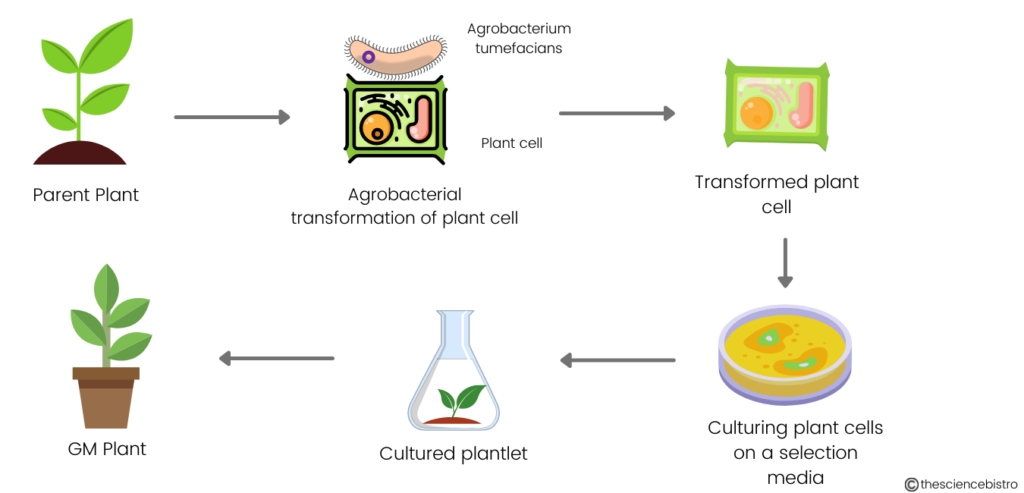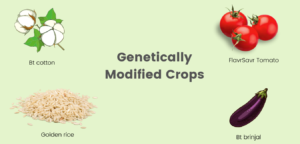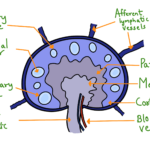Since the domestication of the plants, efforts are made all over the world to increase the yield of plant products and obtain different plant products via conserving the useful traits in plants. In the recent era, a relatively new technique has come up which is known as Genetic Modification of plant genomes to develop plants better suited for the benefits of humans. Each organism has its genome which consists of many genes determining the genotypic as well as the phenotypic characters of the organism. The genetic modification technique modifies the genome of the plants which is in the form of DNA. This method can also be called Genetic engineering or transgenesis. In most cases, the aim of producing a GM crop is to introduce a new gene in a plant genome which is normally absent in wild-type plants. The characters that are usually targeted in making GM crops that can be made available commercially include longer shelf life, pesticide resistance, herbicide resistance, biotic and abiotic stress tolerance, etc.
History of GM Crops
The journey of Genetic modification towards success was a combination of few discoveries which when put together gave rise to the new technique of genetic modification. The Discovery of enzymes that can cut DNA at specific positions and allows scientists to isolate the gene of interest in the 1970s, the discovery of DNA ligases enzymes involved in the joining of the two strands, the discovery of plasmids in 1952, and finally the discovery of tumor-inducing agent ‘Ti plasmid’ from Agrobacterium tumefaciens in 1970 led to the discovery of the new technique of genetic modification.
The first report of the genetically modified plant came in 1983, the plant was antibiotic-resistant tobacco which was developed by inserting the antibiotic resistance gene in the Ti plasmid of Agrobacterium. Plant Genetic Systems, founded by Marc Van Montagu and Jeff Schell in 1987, was the first venture to use genes from Bacillus thuringiensis (Bt) to genetically create insect-resistant plants by inserting them into tobacco. In the course of time, many approvals were given by FDA as well as by European Union to commercialize Genetically Modified plants.
Process of genetic modification
The method starts with discovering a gene of interest. The gene or a set of genes responsible for the desired trait is first discovered. This is usually done at the laboratory level by using techniques like genome and transcriptome analysis. Once the gene or a set of genes is identified the next step is to incorporate that gene into the genome of the plant cell. This incorporation is usually done at the callus or single-cell level grown by tissue culture technology.
The most common method used for the incorporation of the gene is the particle bombardment method by using Biolistic guns (gene guns). In this method, the gene of interest is coated on a tungsten or gold particle. These particles are shot towards the plant tissue or a single cell of a plant under high pressure. Due to the high pressure, the particle penetrates both the cell wall as well as the cell membrane and goes inside the nucleus. The gene then separates from the particle and is incorporated into the genome of the plant at a random position.
Another most commonly used method is ‘Agrobacterial transformation’. Agrobacterium is a naturally occurring bacterium that is known to cause Crown Gall disease (forming tumors on plants). It has been discovered that it is the Ti plasmid (Tumor inducing plasmid) that is responsible for the formation of tumors in plants after agrobacterial infection. The tumors are formed when a part of the Ti plasmid known as T-DNA is transferred from the bacterial DNA to the plant DNA and is inserted at a random position. This property of the agrobacterium is used to create GM plants in which the bacterium is designed in such a way that the T-DNA region in Ti plasmid is removed and gene of interest is inserted at the position to form a recombinant Ti plasmid. This modified agrobacterium is now allowed to infect plant cells grown by tissue culture. The bacterium incorporates the gene of interest at a random position in the plant genome.
Electroporation is another technique where the DNA containing the gene of interest enters the cell devoid of cell wall because of the pores generated due to short pulses of electric current.
The recent techniques developed include using CRISPR and TALEN to incorporate genes of interest in plant cells.

List of GM crops available in the market
Bt cotton
Bt cotton is a GM plant widely cultivated across India and some other countries. In Bt cotton, a gene coding for an endotoxin known as ‘cry’ gene isolated from a soil bacterium Bacillus thuringiensis is incorporated in the genome of cotton plants for resistance against the insects like moths and butterflies, beetles, cotton bollworms and flies.
FlavrSavr tomato
FlavrSavr tomato developed by the company ‘Calgene’ is a tomato having better shelf life as compared to other tomatoes. In FlavrSavr tomato, a gene is inserted which interferes with the production of the enzyme ‘Beta Polygalactouronase’. This enzyme is involved in the degradation of pectin in the cell wall which leads to rotting. Adding a transgene interfering with the production of Beta Polygalactouronase makes FlavrSavr tomato a rotting resistant variety.
Golden rice
Vitamin A deficiency causes a range of diseases such as xerophthalmia, night blindness keratomalacia and corneal scars, and permanent blindness. Golden rice is a rice variety (Oryza sativa) that has been genetically modified to produce beta-carotene, a precursor to vitamin A, in the edible sections of the grain.
Ethical concerns for GM crops
Several ethical concerns have been raised against GM crops. One of which is the potential of GM crops in causing allergies and diseases. A gene picked up from an allergic source could be placed in a non-allergic host and a person can unknowingly consume the product which can lead to an allergic response. Also, as the source of the gene in GM plants can be from bacteria and viruses the possibility of the occurrence of a disease cannot be avoided. These genes especially antibiotic-resistant genes may get transferred to certain bacteria making them resistant to antibiotics via a process of vertical gene transfer. Another concern regarding GM crops is damage to the environment. As the field of GM crops is relatively new we don’t the exact effect of these crops on the environment if we fail to confine these crops in a particular area. Cross-pollination can occur between wild variety and genetically modified variety which can lead to contamination of the natural gene pool of plants. GM crops also raise a potential threat to the food web. Animals and other species in the environment could be harmed by any pesticide or herbicide from the crop. For example, weeds were successfully reduced by GM sugar beets that were engineered to be herbicide-resistant. Skylark birds who eat the seeds from this particular weed, on the other hand, would have to find a new food source, putting their survival in jeopardy. For the time being, it is hoped that people would become more informed about the ethical considerations surrounding genetically modified foods, which will hopefully lead to increased research and accountability in the field.




